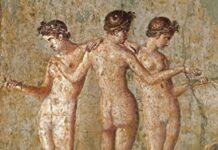
Ebook Info
- Published: 2011
- Number of pages: 316 pages
- Format: PDF
- File Size: 11.48 MB
- Authors: Michael Grant
Description
The definitive study of Rome by one of the 20th century’s finest ancient historians. A richly detailed portrait of Rome at the height of its glory.
User’s Reviews
Reviews from Amazon users which were colected at the time this book was published on the website:
⭐The crisis of the third century was unlike anything Rome had ever experienced before. The army raised dozens of emperors only to turn on them and take them down. For the fifty years following 235 there were no less than 27 recognized emperors and many other unsuccessful usurpers. Only one in that time died of natural causes, in a plague that devastated the empire. Worse still a series of barbarian invasions penetrated deep into Roman territory threatening the very heart of the empire. The Goths in the north penetrated into Italy while the Persians sacked much of the east including the imperial capital at Antioch. At its peak the empire was split into three feuding states fighting each other as they tried to fend off the barbarians. This crisis didn’t end until Diocletian took the throne in 284. The empire would never be the same again.Unlike many books on the period this one focuses more on the written and visual culture of the empire. Much of this book is dedicated to a summary of the literature and philosophy which came out of this time. In this way it is a very traditional literary analysis of the type favored by many classicists, although the choice of the third century alone makes it special. Classics usually ends in the 2nd century since the 3rd century and onwards is considered to be inferior and derivative of classical works. Grant isn’t buying that and he works quite hard to prove that this period is valuable as a focus of study.Grant’s interesting claim is that the 3rd century actually represented the climax of Roman civilization. It’s an interesting view and one that he tries hard to prove. Generally speaking modern scholars focus on the similarities between the 3rd century and the succeeding ones, but this is due more to the periodization known as Late Antiquity than any real resemblance. It is very healthy to keep in mind that it was connected with the previous era as well. In fact the period shares a good deal more similarities with the preceding era than the following one. Climax is kind of a tricky word since it has so many different variations in meaning. It does seem to suggest that this was a high point of Roman culture which is something I’d mostly disagree with. On that point he does show that in several fields including law, art, and novels it was indeed greater than what came before or after. But generally speaking this period represents the last appearance of classical Roman culture. Which could well fit under the term ‘climax’ as well. I rather like the ambiguity in fact. I’d have probably called it something less catchy like ‘The Last Appearance of Classical Culture in the Roman Empire.’ I think his wording is better.I have to say that I’ve had problems with Grant’s works in the past. Some of his newer works are sloppily written and many times he simply slaps some old essays together and calls it a day. His
⭐covers the same material as this except that it’s composed entirely of excerpts from the Oxford Classical Dictionary. But I am developing a real appreciation for some of his older works. Grant is a classicist in the highly traditional sense. He is interested in economics, politics, and the military, but his main interest is in the art and culture of the period. Sometimes he chooses subjects that don’t reflect this well enough but when he’s on the right topic he is superb. Needless to say this topic is good for him. Looking at this period with a traditional eye he goes into a lot of things that Late Antique specialists just don’t care as much about. Literary quality is subjective after all, and so is artistic merit. His analysis of this material provides an excellent reference for the works of this period and the changes that they underwent. There is more to the book than that of course and he provides detailed examinations of the changing nature of government and religion. But this material is now available elsewhere whereas his artistic analysis is almost unique in popular works. This book is highly recommended (and cheap) for those with an interest in the period. It’s informative, easy to read, and contains some great pictures.Those interested in reading more about this time period have a few options.
⭐provides an excellent narrative of the period, which might be useful since the current book assumes such knowledge already.
⭐provides similar information but goes into greater detail in many areas and carries the narrative on down through 395.
⭐is a look at the entirety of the later Roman Empire and deals fairly briefly with the 3rd century. It should be noted that this book’s focus is on proving the point that the downfall of Rome was due almost solely to the willingness of the army to conduct civil wars. In other words he doesn’t go much into social or artistic changes. And of course the old classic for the period, Edward Gibbon’s
⭐. This book is a wee bit outdated (the first edition was published in 1776) but still remains a powerful read. The first volume covers all of the period in question.
⭐The book was hard to read and at times boring. The author goes in detail about the times, but he’s all over the place jumping from different era’s to prove a point. I wouldn’t recommend this book.
⭐An interesting book for those who know the history of Rome, since it is not about chronological events. The purpose of the book is to draw a picture of the roman society of a certain period. So if one does not know the history of Rome, one could find it rather complicated.
⭐Mr Grant teases out the subtle connections in the shifts of Roman civilization.The debasement of the currancy.The drift of religious philosophy away from the certainty of a conquering nation to a defensive totalitarian state of doubt and decadence-of ‘Yes we can , we are right’ to ‘What does it all mean’-my interpretation.Of the attempts to reinvigorate the mission with ‘slogans’ and maxims.Does this sound familiar?This is history at its best.Soberly written ,telling the story by examples and analysis.The chapters are well organized by topic.He does not lead the reader by the nose , much to reflect apon and mostly relevant stuff unlike Tuchman’s ‘Distant mirror’ .Mr Grant leaves the reader to reflect, what if anything caused these twists and turns of society , art and politics.I have read lots but not about Rome but I like this style book.You can wake up in the middle of the night read this book and go back to sleep.Unthrottled.4 stars because I’m not an expert.I’m quite surprise I’m the first reviewer.
Keywords
Free Download The Climax Of Rome in PDF format
The Climax Of Rome PDF Free Download
Download The Climax Of Rome 2011 PDF Free
The Climax Of Rome 2011 PDF Free Download
Download The Climax Of Rome PDF
Free Download Ebook The Climax Of Rome



